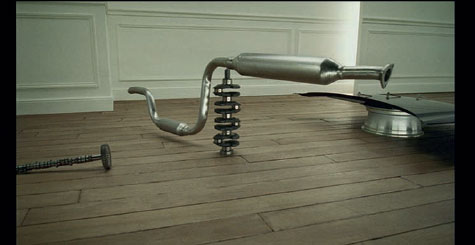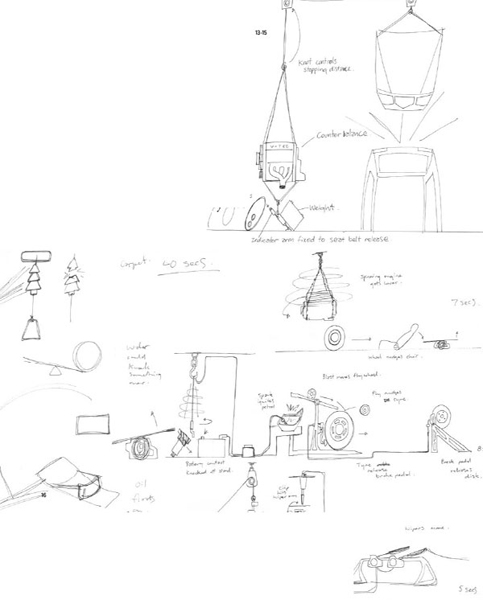14/
Honda
Cog
Wieden + Kennedy London
When Wieden + Kennedy in London launched its Honda Cog commercial in 2003, it caused surprise, delight and controversy in equal measure. Running at two minutes in length, the film is elegant and seemingly simple, showing an epic chain reaction constructed from parts of the Honda Accord car. Despite being intrinsically linked to the Accord, the spot was in fact originally written in response to a brief for the Honda Civic. ‘We wrote this for the Civic because the Civic absolutely felt like the beauty of function,’ says Ben Walker, who created the ad alongside Matt Gooden. ‘The Civic is Honda’s real baby; they’re more proud of that car than they are of their racing cars.… For them, the Civic is the embodiment of what makes Honda so brilliant.’
‘We thought, what’s the best way of showing the beauty of function? We remembered a film by Fischli & Weiss [Der Lauf der Dinge/The Way Things Go], which is an amazing film. We thought, surely we can make something using the car that would have the same beautiful function and show the engineering,’ Walker continues. ‘Honda loved the idea, but only had six weeks to make the ad, so ended up making something else.’ When the Honda Accord brief came along at a later date, though, the client suggested that the team revisit their idea, and work on Honda Cog began. ‘I think with all these things there’s a series of lucky events that make it fall into place,’ says Walker. ‘The lucky thing about Cog was that Honda was desperate to turn the Accord into a sector D car, which is more expensive, so they really wanted to tell an engineering and a beauty story. They wanted to raise the level of this car, and they saw that car parts and showing this absolute finesse was a way of doing that. So they bought into it.’
Walker and Gooden began work on the spot by exploring different chain reaction ideas with the car parts, to see whether the idea would even be feasible. The intention was to create a spot that had an evident human touch, which would stand out among the slick CGI styling that was ubiquitous in car ads at the time. From the very start, Walker and Gooden were keen that the chain reaction should be real, and therefore plausible to viewers. ‘I remember the script,’ says Walker. ‘It’s the most boring script you’ve ever read! We’re always banging on to people to make scripts quick and succinct, and we wrote this two-page script that was wall-to-wall words, saying things like “then the exhaust pipe turns slowly into a piston key…”. It was really boring but we felt it was an exercise we had to do to prove to people that we really wanted to genuinely make the best chain reaction we’d ever seen.’



01-04 Stills from the finished Honda Cog commercial. Running at two minutes in length, the ad featured an epic chain reaction made from different parts of the Honda Accord car, including the windscreen wipers and the exhaust pipe.
’It’s an amazing editing job that everyone thinks is one shot.’


05, 09 Sketches for the Honda Cog ad show the planning for many of the effects that appeared in the final chain reaction.


06-08, 10-12 The team created the set for the shoot in a warehouse in Paris. The set took three months to build.
‘What we found in the end, though, is that we wrote this incredibly precise script, but we were totally guessing at everything,’ he continues. ‘We had ball bearings dropping down into half a tyre and then rolling up and out, and we didn’t even know whether a ball bearing could do that. It got to a stage where you had to start testing things.’
At this point, Walker and Gooden commissioned French director Antoine Bardou-Jacquet to work on the project, in part because of a complex animated music video he had directed for musician Alex Gopher, which featured whole cities constructed out of type. ‘From his animation stuff, you just knew that he had a detailed mind, and that’s what made us choose him,’ Walker explains. ‘Well, that’s what interested us in him. What made us choose him above all the other people we spoke to was because his treatment was not so much about what he was going to film, but the team of people he was going to get together to help build it. He was concentrating totally on the right part of it. He got this amazing team together and said, “if we’re going to crack this, we need to have all these people on board”. That’s why he won the job.’
The team spent a month testing whether the chain reaction would work. Having discovered it would, a further three months were then set aside to build the actual chain. The construction took place in a warehouse space on the outskirts of Paris. ‘We used every single minute of the three months,’ says Walker. ‘In fact, we could have gone on. There are still bits when I see it now… there’s a bit just after halfway that I don’t think is very good and I think we ran out of time on that. We had this spinning cylinder thing, which span beautifully and knocked something else, and it worked all the way through testing, and then come the shoot it just didn’t work and everyone was baffled as to why. So we had to quickly think of something else, and it’s not very good what we thought of.’
Despite Walker’s concerns, the film is full of amazing moments, all timed to perfection. Tyres roll uphill, windscreen wipers dance. At one point, a tiny rod spins delicately before hitting a connection that starts up the car’s engine, and in turn its stereo. The music that pumps out is The Sugarhill Gang’s Rapper’s Delight, which was chosen over What You Give Is What You Get by The Jam. ‘It was quite a big old decision,’ says Walker of the music, ‘I wanted The Jam, because I thought it was more boy racer, but I think Rapper’s Delight is more classic.’ The spot then ends with a shot of the finished car and a final comment from Garrison Keillor, the U.S. writer and broadcaster and the ‘voice’ of Honda, who proclaims, ‘Isn’t it nice when things just. work’.
The ad only aired on TV a few times, largely because of its length. Much of the momentum around its launch was achieved via the internet, despite it being the early days of viral marketing. Within 24 hours of the ad’s launch, the Honda website received a deluge of visitors, many of whom requested a DVD version of the film, in response to an offer made online.
Alongside the accolades, Cog quickly began to also receive criticism. This centred around accusations of plagiarism, specifically from the artists Fischli & Weiss, who felt it was too similar to the art film that had informed Walker and Gooden’s early ideas for the spot. The art duo threatened to sue, though in the end no lawsuit was brought.
‘The lucky thing about Cog was that Honda was desperate to turn the Accord into a sector D car, which is more expensive, so they really wanted to tell an engineering and a beauty story. They wanted to raise the level of this car, and they saw that car parts and showing this absolute finesse was a way of doing that.’
‘It’s the most boring script you’ve ever read! We’re always banging on to people to make scripts quick and succinct, and we wrote this two-page script that was wall-to-wall words, saying things like “then the exhaust pipe turns slowly into a piston key…”’

13-15 More drawings showing various ideas for how the Honda Accord car parts might be used in the chain reaction. The notes on the sketches are written by the advertising agency creatives, Ben Walker and Matt Gooden.


16-21 Production photographs taken during the construction of the set for the Honda Cog ad, as well as on the shoot itself.



22-25 Photographs taken on the set for Honda Cog. When the finished film was released, it was rumoured that it had taken over 600 takes to complete, although the creatives now say it was probably around 100. Due to its length, the ad only aired on TV a few times, though was covered in the media across the world and quickly became an advertising sensation.
Looking back at the controversy now, Walker and Gooden are adamant that Cog remains distinct from The Way Things Go. ‘We got a tape together of hundreds of chain reactions,’ says Walker. ‘From the beginning of [BBC television series] The Great Egg Race, the chain reaction in The Goonies, Heath Robinson… we had a lot of Heath Robinson stuff in. We had this wonderful tape, which Fischli & Weiss’s film was bang in the middle of. Of course, if you’re going to attempt a chain reaction, if you haven’t looked at what they’ve done, you’d be an idiot. We never denied that, but we wanted to do something different. People still argue about it, but we genuinely set out to do something different. The film from start to finish took six months, and if we’d just been ripping off what they’d done, we could have done it in six weeks.’
Regardless of these critical rumblings, Cog went on to be hugely influential, especially on other ads. As testament to its success, a number of spoof versions were created for other brands, and the ad arguably began a trend for using authentic stunts in ads (instead of CGI) that lasted for years, spawning spots such as Skoda’s The Baking Of (see page 164) and Sony’s Balls (see page 172).
A surprising amount of mythology grew up around the ad too, much of which turns out to have been exaggerated. It was rumoured that the spot had taken more than 600 takes to complete, though in fact it was probably around 100, according to Walker and Gooden. They also dispel the enduring myth that it was filmed in one complete run. ‘The only reason we didn’t do that in the end was because we couldn’t find a studio that was literally long enough,’ says Walker. ‘So Antoine’s idea was to split the ad in half and sew the two halves together.’ To counter this element of fakery, the team made sure that if the space were large enough, the chain reaction as it stands would indeed have worked. In the end though, there were several different joins in the final spot. ‘That’s the amazing thing about that film – there are actually three or four edit points in there,’ says Walker. ‘Because the flow of it was slightly better on one take than on another, not because you couldn’t do it. And you can’t see those bloody joins, which is incredible.’
‘A lot of it’s to do with timing as well,’ Walker continues. ‘Because each time you did the chain reaction, it lasted a different amount of time. Obviously if we’re doing something in exactly two minutes, you couldn’t have that – so we had to speed bits up, slow bits down, chop new bits in. It was very complicated, and in fact as an editing job, it was quite amazing. It’s an amazing editing job that everyone thinks is one shot.’
